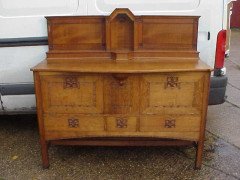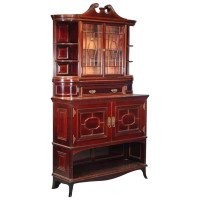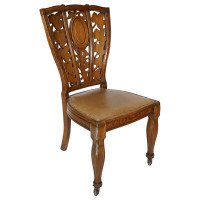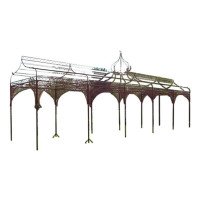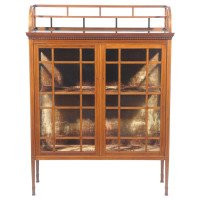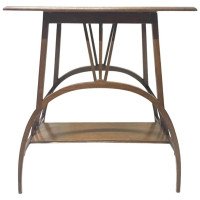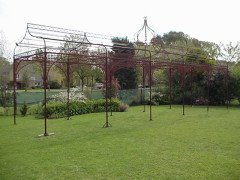E W Godwin for William Watt. A rare and important Anglo-Japanese walnut bookcase,
POA
Edward William Godwin (attributed) for William Watt. A rare and important Anglo-Japanese walnut bookcase, circa 1871, with brass handles and shield style escutcheon, the lower cupboard with two sliding doors inset with painted panels attributed to Henry Stacey Marks. See Soros, Susan Weber 'The Secular Furniture of E.W. Godwin' Yale 1999, p. 201, plate 321 an illustration of a related example. See also Christie's sale 'important 20th Century Design' 26th May 2005, lot 47 In 1949 Dudley Harbron photographed and recorded a bookcase that he concluded had been made for Dr. George Bird. A friend of Ellen Terry (See Godwin's ledger for 17th September 1871) and the father of Elfrida Bird who married Luke Ionides. That bookcase, now cut-down, together with another corresponding example, was then in the possession of Mrs Lewis Clarke, having been inherited from her grandfather, Alexander Ionides son of Elfrida and Luke. A third bookcase was known to have been in the possession of Mrs Alecco Ionides at about the same time (Soros, p.201). Despite Harbron's research and evident interest in these bookcases, they were poorly maintained by their owners. And two were thought to be destroyed (Soros, p.201), whilst one of the examples had its shelved superstructure removed and discarded. Susan Soros notes that this cut-down version is in 'stained oak' but one can clearly see in her illustration (Soros, p.201), it is not made from polished oak at all but exactly like the present example made from walnut. Both being made from walnut and both having identical measurements to their bases gives even more weight towards the most likely event that only one of the three cabinets was completely destroyed and the cut-down version is quite likely to be one of the two thought to have been destroyed, which it partially was. The present example is the only known example in existence to have emerged intact and is therefore unique! The painted panels to the cut-down 'Bird-Ionidies' example depict scenes from Greek antiquity. On the present version there is a painted panel to one side probably by Henry Stacey Marks, the attribution made by Christie's Art department and Susan Weber Soros. And is in good condition. The pencil and watercolour cartoon to the other panel, although quite faded and somewhat distressed, has the feel of Edward Burne Jones's work and interestingly the panels were originally believed to be executed by Burne Jones although Harbron in 1949 maintains the panels were painted by Charles Glidden who died young at 20 years of age. This panel has been attributed to Henry Stacey Marks by Christie’s art department. Henry Stacey Marks is well documented to have painted for Godwin, to whom the panel of the present lot is attributed and which is also in the Greek style. The figures in the painted panel are of two men helping an injured man and possibly may have been in combat with the knight in the other panel. And again their attire does also point to Greek Mythology. The opposite panel is quite different and depicts a prince or knight about to kiss a maiden or a princess, she is looking into his eyes, reaching out and touching his arm about to kiss. There is a sword lying at his feet and his own sword is held to his waist or in his belt with the blade in view and the point to the earth, it looks as if there may be the tail of what could be a dragon adjacent to the sword and possibly a person that may have been slain lying by the maiden. In the right-hand corner there is a castle with banner flying and a crescent moon beside it. The Ionidies family were probably the biggest and most generous patrons of the Arts, building one of the most important and impressive collections in the late Victorian Period. And refined collectors of Art from The Aesthetic Movement, Ionidies’s pool of artists to choose from was thoroughly connected through his high society circle of friends which included Edward Calvert and George Frederick Watts, who painted their family portrait when Luke was a child, James McNeill Whistler, Edward Poynter, George Du Maurier, Thomas Armstrong, Dante Gabriel Rossetti and Edward Burne Jones. William Morris, Phillip Webb, Walter Crane and Thomas Jeckyll, all part of his circle of friends, were commissioned to re-decorate 1 Holland Park, their family home, which is all well documented. Henry Stacey Marks (1829-1898) was a painter, watercolorist and illustrator, who worked as a muralist and decorator for Burges, Godwin and Waterhouse. In 1869 Marks was commissioned by Godwin to execute an allegorical frieze to the dining room of Dromore Castle, but due to the incurable dampness of Dromore's enormously thick walls it never came to fruition. An important point is that on the present example there are two brass lock plates to the right-hand side, one in the middle of the central upright that runs through the middle of the bookcase side and another one in the middle of the same central upright but located in the middle of the lower cupboard, these plates (one now missing) were used for joining two bookcases together and would have utilised a brass thumbscrew (also now missing). The sides of this bookcase and the 'Bird-Ionides' bookcase are completely flat from top to bottom which allows for them to butt up perfectly. A design detail that until now was unknown. And which gives even further strength to this present version being one of the very original pair. The present bookcase has a depository label to the back of Famine's, Colchester and handwritten 'G.M.LAWRENCE', Mrs G M Lawrence, was the last in possession of it in 2004. The Lawrence family owned a very successful lemonade and ginger ale company with factories and warehouses in Beccles, Bungay and Halesworth, Suffolk. It was removed from Mrs G M Lawrence’s house by Durrants auctioneers, one of the original houses that were built by the Lawrences in Station Rd, Beccles. At some point in its life it made the journey down from London to Colchester and spent some time there, although exactly where is unknown. It seems its next move would have been from Colchester to Beccles. The measurements of the cut-down version are identical to the lower half of this version, in Soros, Susan Weber ‘The Secular Furniture of E.W. Godwin’ the cut down version measures 35 1/4" high, which is the very same height to the open area of this present version. And again the depth and width of both of these examples are identical 19" deep, 39" wide. The present version measures 89 1/2" high. Circa 1871. Height 85 1/2" 217cm, Width 39" 99cm, Depth 19" 49.5.


